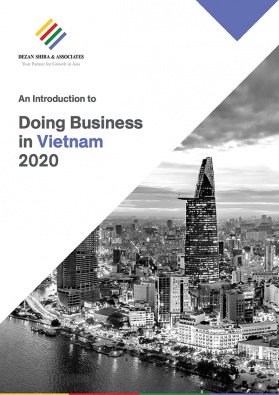COVID-19 and the Effects on Supply Chains in Vietnam
The COVID-19 pandemic has slowed global trade and disrupted supply chains. The virus, which first started in China, shut manufacturing facilities for an extended period of time. As China, known as the factory of the world, shut factories, it resulted in a ripple effect battering global supply chains with businesses struggling to source raw inputs.
This has particularly affected Vietnam, which relies on China for importing raw materials for its industries while also exporting to the country. A survey in February by the American Chamber of Commerce (AmCham) revealed that a majority of its members were reporting difficulties in sourcing supplies and materials from Chinese suppliers. In addition, 70 percent of its members stated they were operating at just 70 percent capacity.
Businesses suspending production
Several automobile manufactures including, Honda, Toyota, Nissan and Ford that have production plants in Vietnam have suspended production due to the pandemic. Business across all sectors in Vietnam are facing disruptions particularly as Vietnam is currently in a two-week social isolation program until April 15, where only essential businesses operate.
Vietnam economy resilient: World Bank
And yet, while Vietnam remains exposed to COVID-19, its economy remains resilient as per the World Bank. In its report East Asian and the Pacific in the Time of COVID-19, Vietnam due to its integration with the global economy has suffered due to the pandemic particularly hurting manufacturing and tourism. Nevertheless, exports expanded by 8 percent in the first 2 months of the year, while FDI inflows amounted to US$2.5 billion.
While this remains a difficult time, Vietnam is poised to overcome the ongoing crisis. The report further states that while the pandemic can affect Vietnam’s economy in the short term – if the virus is contained – in the long-term Vietnam can manage external risks by diversifying trade flows and improving competitiveness.
Supply chains upended
Even so, with borders closed and trade limited – countries are likely to stagger opening their borders for regular operations. For example, when a port in Wuhan – the epicenter of the pandemic – opened for business, several countries in that same week closed their borders. Ethiopia closed its land borders, Myanmar canceled all commercial flights, while the US, Canada, and most of Europe introduced restrictions.
In addition, most countries if not all, have suspended passenger flights. Vietnam itself suspended all international passenger flights on April 1, while domestic flights are extremely limited during its social isolation period. The issue with this is that commercial passenger planes also carry freight and with fewer planes flying, air freight prices have spiked. In China, these rates have spiked by 200 percent to destinations in Southeast Asia, and more than 100 percent to Europe and the US according to the TAC index which measures air freight rates.
Most recently Samsung, which makes most of its smartphones in Vietnam, had to fly spare parts and components. With lockdowns in most countries likely to remain in place for the foreseeable future, air freight rates are expected to continue to rise.
On the other hand, with less demand, canceled orders are resulting in a decline in export orders forcing companies to lay off staff. Most recently, with COVID-19 cases spreading exponentially in the US and a slowdown in its consumption market – furniture production units in Vietnam are feeling the effects. To cope, several plants have reduced their workforce and have temporarily shut down production lines. Some factories are taking extended time off, while some are running staggered shifts with reduced hours.
Opportunities in online shopping
While the pandemic has been disastrous for some, it has created opportunities for others. Online grocery shopping, in particular, has jumped, while food delivery services are popular as well. BigC supermarket chain said that its stores in southern Vietnam reported 3000 online orders in March, up 1,000 from the previous month.
The pandemic has changed consumer trends; a survey by Nielsen Vietnam revealed that people reduced their frequency of visits to supermarkets by 50 percent. As Vietnam’s e-commerce is still growing the pandemic has accelerated this shift.
What can businesses do to keep their supply chain resilient?
Diversify
Businesses in Vietnam remain reliant on sourcing inputs from China. The pandemic is a good wake up call for businesses to diversify. Big firms such as Apple, Google and Samsung have already been doing this. Firms have also been looking to source from other destinations such as India. The government can also do its part.
For example, Japan has set aside more than US$2 billion in its coronavirus recovery package to help firms shift production out of China showing its reliance on China. Last year Vietnam imported almost US$4 billion in car parts. As raw materials from China get squeezed Vietnam could look to South Korea and Japan for inputs.
Businesses will have to if not already look at ways to wean off China to protect their supply chains. This means looking at other locations depending on the type of industry and raw materials. It would be best to look at different geographical locations to ensure that the supply of raw materials remains intact with contingency plans in place. With demand slowing down, this would be a good time for investors to do a check.
Online distribution channels
Businesses that haven’t already should invest in online distribution channels and last-mile connectivity. With more consumers working and staying at home, opportunities to reach out to customers directly will be imperative. This means that traditional mortar-and-brick stores can still keep a physical presence but they should also look at ways to interact and deliver direct to consumers.
Third-party logistic (3pL) providers can alleviate some of this demand, but during this time, they are likely to be stretched. Online shopping also ensures that while there is a dip in consumption, there will always be a demand for products, allowing businesses to operate, albeit at a reduced rate, until the pandemic is contained.
Renegotiate contracts
Renegotiate contracts with suppliers, creditors, and landlords. Businesses need working capital to function and so can reduce costs by working with suppliers to renegotiate contracts. This may mean buying raw materials on a limited scale or delaying shipments. Businesses can also negotiate with customers to pay early by giving them discounts or other concessions to continue cash inflows. Businesses may consider buying in bulk at reduced rates and store inputs to prepare for the long term.
Businesses should try and maintain operations
Shutting down production and re-starting can be an expensive endeavor. Businesses should try and reduce operations as much as possible without having to shut down operations. Restarting operations may require a business to find new suppliers and employees. In addition, machinery that is out of production requires maintenance and additional costs to get up to speed when production resumes. These can be a drain on a businesses’ finances. Companies should do a cost-benefit analysis and see which option suits best.
Government incentives
Apart from this, the Vietnamese government is also working to help businesses affected by the pandemic. Most recently, the government issued Decree 41/2020/ND-CP on April 8. The Decree allows the extension of tax deadlines including VAT, CIT and PIT and land rent for five business sectors for five months.
Supply chains will have to evolve
The COVID-19 pandemic will change how companies do business for years to come. However, it’s important to realize that demand will gradually increase as businesses and consumers adapt in the long term. As noted by the World Bank Vietnam may suffer short term losses but long term fundamentals remain strong and is likely to weather through the crisis.
In addition, apart from Vietnam’s participation in several free trade agreements, the upcoming EU-Vietnam FTA (EVFTA) will bring further opportunities for both sides to expand their economies. Vietnam’s domestic consumption is also a significant driver for investing in the country.
Nevertheless, the pandemic will force businesses and supply chains to evolve. Businesses will have to further innovate and prepare themselves for new demand volumes, patterns and trends. Vietnam remains a long-term strategy and businesses can use the opportunity to learn and prepare their operations for long term growth.
About Us
Vietnam Briefing is produced by Dezan Shira & Associates. The firm assists foreign investors throughout Asia from offices across the world, including in Hanoi and Ho Chi Minh City. Readers may write to vietnam@dezshira.com for more support on doing business in Vietnam.
- Previous Article An Introduction to Rules of Origin for Vietnamese Exports
- Next Article China Plus One: Understanding Vietnam’s Appeal to Investors in Asia







